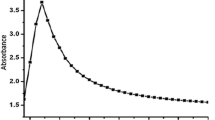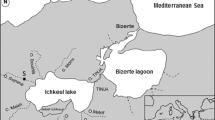Abstract
Nanoparticles are among the particular materials produced by industrial activities; the release of these nanoparticles in natural ecosystems interacts with living organisms. Aquatic environment is the most common estuary waste medium for industrial and all human activities, the consequences may be highly effective on sea food species. Moreover, the potential in situ reduction of metallic ions by preexistent agents leads to nanoparticles which may cause hazardous effects. Many organisms become at risk especially those that use gills during respiration process such as bivalves. The study undertaken investigates the potential effect of silver nanoparticles obtained by green synthesis method on the gills of Ruditapes decussatus as a model. Nanoparticles have been synthesized using Ceratonia siliqua fruit extract as a reducing agent. The organisms have been chronically exposed to silver nanoparticles and the effects were biochemically evaluated. The tests performed show a typical behavior of catalase, glutathione reductase, and glutathione S-transferase activities that give information about the oxidative stress-induced malondialdehyde quantification, which reveals a possible membranous deterioration of the gills. Acetylcholinesterase expression has been qualified to be at a safe rate which implies the capacity of the animal to protect the cholinergic system.







Similar content being viewed by others

References
Barhoumi, B., LeMenach, K., Dévier, M. H., El Megdiche, Y., Hammami, B., Ben Ameur, W., Ben Hassine, S., Cachot, J., Budzinski, H., & Driss, M. R. (2014). Distribution and ecological risk of polychlorinated biphenyls (PCBs) and organochlorine pesticides (OCPs) in surface sediments from the Bizerte lagoon, Tunisia. Environmental Science & Pollution Research, 21(10), 6290.
Bebianno, M. J., & Serafim, M. A. (2003). Variation of metal and metallothioneinconcentrations in a natural population of Ruditapes decussatus. Archives of Environmental Contamination and Toxicology, 44, 53–56.
Bebianno, M. J., Geret, F., Hoarau, P., Serafim, M. A., Coelho, M. R., Gnassia-Barelli, M., et al. (2004). Biomarkers in Ruditapes decussatus: a potential bioindicator species. Biomarkers, 9, 305–330.
Bradford, M. M. (1976). A rapid and sensitive method for the quantitation of microgram quantities of protein utilizing the principle of protein-dye binding. Analytical Biochemistry, 72, 248–254.
Clairborne, A. (1985). Catalase activity. In R. A. Greenwald (Ed.), CRC handbook of methods in oxygen radical research (pp. 283–284). Boca Raton: CRC Press.
Cribb, A. E., Leeder, J. S., & Spielberg, S. P. (1989). Use of a microplate reader in an assay of glutathione reductase using 5,5-dithiobis(2-nitrobenzoic acid). Analytical Biochemistry, 183, 195–196.
Delay, M., & Frimmel, F. H. (2012). Nanoparticles in aquatic systems. Analytical and Bioanalytical Chemistry, 402(2), 583–592. doi:10.1007/s00216-011-5443-z.
Ensibi, C., Pérez-López, M., Rodríguez, F. S., Míguez-Santiyán, M. P., Daly Yahya, M. N., & Hernández-Moreno, D. (2013). Effects of deltamethrin on biometric parameters and liverbiomarkers in common carp (Cyprinus carpio L.). Environmental Toxicology and Pharmacology, 36, 384–391.
Farkasa, J., Christian, P., Gallego-Urrea, J. A., Roose, N., Hassellöv, M., Tollefsen, K. E., & Thomas, K. V. (2011). Uptake and effects of manufactured silver nanoparticles in rainbow trout (Oncorhynchus mykiss) gill cells. Aquatic Toxicology, 101(1), 117–125.
Figueira, E., Cardoso, P., & Freitas, R. (2012). Ruditapes decussatus and Ruditapes philippinarum exposed to cadmium: toxicological effects and bioaccumulation patterns. Comparative Biochemistry and Physiology, Part C, 156, 80–86.
Habig, W. H., Pabst, M. J., & Jakoby, W. B. (1974). Glutathione S-transferases. The first enzymatic step in mercapturic acid formation. Journal of Biological Chemistry, 249(22), 7130–7139.
Hayes, J. D., & McLellan, L. I. (1999). Glutathione and glutathione-dependent enzymes represent a co-ordinately regulated defense against oxidative stress. Free Radical Research, 31, 273–300.
Hidouri, S. (2017). Possible domestication of uranium oxides using biological assistance reduction. Saudi Journal of Biological Sciences, 24, 1–10.
Hidouri, S., Baccar, Z. M., Abdelmelek, H., Noguer, T., Marty, J. L., & Campàs, M. (2011). Structural and functional characterisation of a biohybrid material based on acetylcholinesterase and layered double hydroxides. Talanta, 85(4), 1882–1887. doi:10.1016/j.talanta.2011.07.026.
Lionetto, M.G., Caricato, R., Calisi, A., Giordano, M.E., Schettino, T. (2013). Acetylcholinesterase as a biomarker in environmental and occupational medicine: new insights and future perspectives. BioMed Research International. Article ID 321213. doi.org/10.1155/2013/321213
Lykkesfeldt, J. (2007). Malondialdehyde as biomarker of oxidative damage to lipids caused by smoking. Clinica Chimica Acta, 380, 50–58. doi:10.1016/j.cca.2007.01.028.
Martin, H. L., & Teismann, P. (2009). Glutathione, a review on its role and significance in Parkinson’s disease. The FASEB Journal, 23(10), 3263–3272. doi:10.1096/fj.08-125443.
Mohseniazar, M., Barin, M., Zarredar, H., Alizadeh, S., & Shanehband, D. (2011). Potential of microalgae and lactobacilli in biosynthesis of silver nanoparticles. BioImpacts., 1(3), 149–152.
Moore, M. N. (2006). Do nanoparticles present ecotoxicological risks for the health of the aquatic environment? Environmental International, 32, 967–976. doi:10.1016/j.envint.2006.06.014.
Pei, D., Ding, J., Duan, Z., Li, M., Feng, Y., & Li, C. (2012). Cloning and expression of a tomato glutathione S-transferase (GST) in Escherichia coli. African Journal of Biotechnology, 11(23), 6402–6408. doi:10.5897/AJB12.143.
Qiao, M., Kisgati, M., Cholewa, J. M., Zhu, W., Smart, E. J., Sulistio, M. S., & Asmis, R. (2007). Increased expression of glutathione reductase in macrophages decreases atherosclerotic lesion formation in low-density lipoprotein receptor-deficient mice. Arteriosclerosi Thrombosis and Vascular Biology, 27, 1375–1382. doi:10.1161/ATVBAHA.107.142109.
Recknagel, R. O., Glende, E. A., Walker, R. L., & Lowery, K. (1982). Lipid peroxidation biochemistry measurement and significance in liver cell injury. In G. L. Plaa & W. R. Hewitt (Eds.), Toxicology of the liver (pp. 218–232). New York: Raven Press.
Rosenberry, T. L. (1975). Acetylcholinesterase advances in enzymology and related areas of molecular. Journal of Biology, 43, 103–218.
Šinko, G., Vrček, I. V., Goessler, W., Leitinger, G., Dijanošić, A., & Miljanić, S. (2014). Alteration of cholinesterase activity as possible mechanism of silver nanoparticle toxicity. Environmental Sciences and Pollution Research, 21, 1391–1400. doi:10.1007/s11356-013-2016-z.
Trevisan, R., Delapedra, G., Mello, D. F., Arl, M., Schmidt, É. C., Meder, F., Monopoli, M., et al. (2014). Gills are an initial target of zinc oxide nanoparticles in oysters Crassostrea gigas, leading to mitochondrial disruption and oxidative stress. Aquatic Toxicology, 153, 27–38.
Waggiallah, H., & Alzohairy, M. (2011). The effect of oxidative stress on human red cells glutathione peroxidase, glutathione reductase level, and prevalence of anemia among diabetics. Journal of Medical Sciences, 3(7), 344–347. doi:10.4297/najms.2011.3344.
Zhao, Y., Dou, J., Wu, T., & Aisa, H. A. (2013). Investigating the antioxidant and acetylcholinesterase inhibition activities of gossypium herbaceam. Molecules, 18, 951–962. doi:10.3390/molecules18010951.
Zohra, B. S., & Habib, A. (2016). Assessment of heavy metal contamination levels and toxicity in sediments and fishes from the Mediterranean Sea (southern coast of Sfax, Tunisia). Environmental Science and Pollution Research International, 23, 13954. doi:10.1007/s11356-016-6534-3.
Acknowledgements
Dr. Hidouri is truthfully grateful to the Department of Biology, Faculty of Science of Bizerte Carthage University for availing the required facilities throughout the experimental period of this work. The authors would like to thank anonymous reviewers and the editing board for the efforts given throughout the publication process.
Author information
Authors and Affiliations
Corresponding author
Rights and permissions
About this article
Cite this article
Hidouri, S., Ensibi, C., Landoulsi, A. et al. Effects of Chronic Exposure to Silver Nanoparticles on Ruditapes decussatus Gills Using Biochemical Markers. Water Air Soil Pollut 228, 79 (2017). https://doi.org/10.1007/s11270-017-3265-0
Received:
Accepted:
Published:
DOI: https://doi.org/10.1007/s11270-017-3265-0



